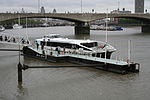Statue of Robert Raikes, London

A statue of Robert Raikes, often regarded as being the founder of Sunday schools, executed by the sculptor Thomas Brock, stands in Victoria Embankment Gardens, London, United Kingdom. It was unveiled by the Earl of Shaftesbury on 3 July 1880 and marked the centenary of the opening of the first Sunday school. The critic Edmund Gosse considered the statue to be "as good as anything of the kind we possess in England". In 1958 it was designated a Grade II-listed building.The front of the plinth reads: ROBERT RAIKES/ FOUNDER OF SUNDAY SCHOOLS/ 1780/ THIS STATUE WAS ERECTED/ UNDER THE DIRECTION/ OF THE SUNDAY SCHOOL UNION/ BY CONTRIBUTIONS/ FROM TEACHERS AND SCHOLARS/ OF SUNDAY SCHOOLS IN GREAT BRITAIN/ JULY 1880. An inscription below the figure's right foot reads: THOS BROCK SCULPT/ LONDON. 1880.In 1929 replicas of the statue were cast for erection the following year in Gloucester and Toronto, for the 150th anniversary the following year of opening of the first Sunday school.
Excerpt from the Wikipedia article Statue of Robert Raikes, London (License: CC BY-SA 3.0, Authors, Images).Statue of Robert Raikes, London
Savoy Place, City of Westminster Covent Garden
Geographical coordinates (GPS) Address Nearby Places Show on map
Geographical coordinates (GPS)
| Latitude | Longitude |
|---|---|
| N 51.50934 ° | E -0.12029 ° |
Address
Robert Raikes
Savoy Place
WC2N 6BJ City of Westminster, Covent Garden
England, United Kingdom
Open on Google Maps










